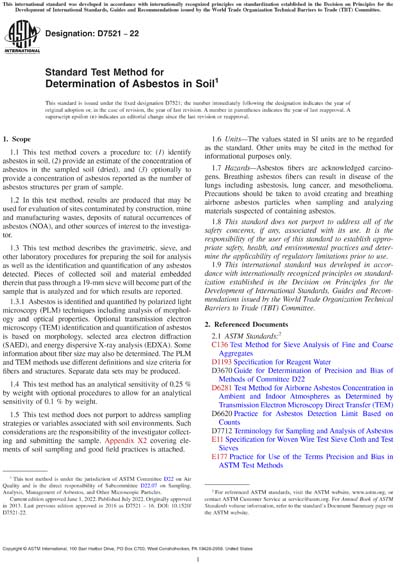Most recent
ASTM D7521-22
Standard Test Method for Determination of Asbestos in Soil
1.1This test method covers a procedure to: (1) identify asbestos in soil, (2) provide an estimate of the concentration of asbestos in the sampled soil (dried), and (3) optionally to provide a concentration of asbestos reported as the number of asbestos structures per gram of sample.
1.2In this test method, results are produced that may be used for evaluation of sites contaminated by construction, mine and manufacturing wastes, deposits of natural occurrences of asbestos (NOA), and other sources of interest to the investigator.
1.3This test method describes the gravimetric, sieve, and other laboratory procedures for preparing the soil for analysis as well as the identification and quantification of any asbestos detected. Pieces of collected soil and material embedded therein that pass through a 19-mm sieve will become part of the sample that is analyzed and for which results are reported.
1.3.1Asbestos is identified and quantified by polarized light microscopy (PLM) techniques including analysis of morphology and optical properties. Optional transmission electron microscopy (TEM) identification and quantification of asbestos is based on morphology, selected area electron diffraction (SAED), and energy dispersive X-ray analysis (EDXA). Some information about fiber size may also be determined. The PLM and TEM methods use different definitions and size criteria for fibers and structures. Separate data sets may be produced.
1.4This test method has an analytical sensitivity of 0.25 % by weight with optional procedures to allow for an analytical sensitivity of 0.1 % by weight.
1.5This test method does not purport to address sampling strategies or variables associated with soil environments. Such considerations are the responsibility of the investigator collecting and submitting the sample. Appendix X2 covering elements of soil sampling and good field practices is attached.
1.6Units - The values stated in SI units are to be regarded as the standard. Other units may be cited in the method for informational purposes only.
1.7Hazards - Asbestos fibers are acknowledged carcinogens. Breathing asbestos fibers can result in disease of the lungs including asbestosis, lung cancer, and mesothelioma. Precautions should be taken to avoid creating and breathing airborne asbestos particles when sampling and analyzing materials suspected of containing asbestos.
1.8This standard does not purport to address all of the safety concerns, if any, associated with its use. It is the responsibility of the user of this standard to establish appropriate safety, health, and environmental practices and determine the applicability of regulatory limitations prior to use.
1.9This international standard was developed in accordance with internationally recognized principles on standardization established in the Decision on Principles for the Development of International Standards, Guides and Recommendations issued by the World Trade Organization Technical Barriers to Trade (TBT) Committee.
Content Provider
ASTM International [astm]






